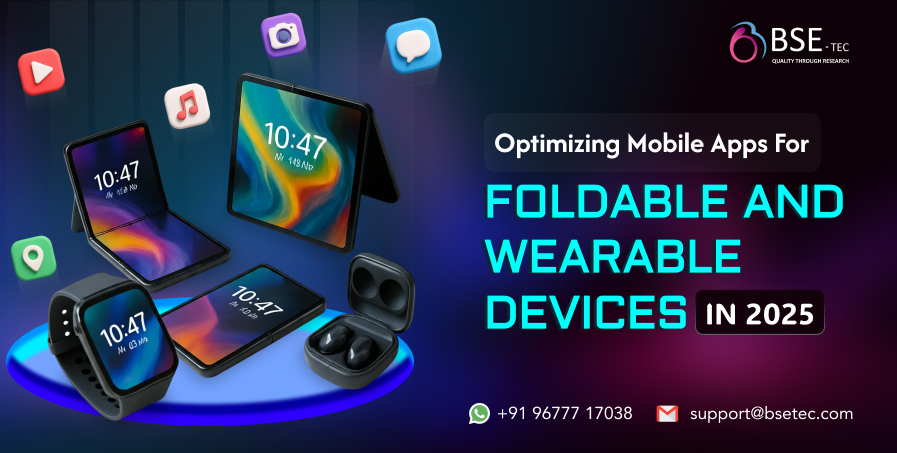Optimizing Mobile Apps for Foldable and Wearable Devices in 2025

Introduction: The Next Evolution of Mobile Apps
The year 2025 marks a turning point in mobile technology. With foldable smartphones, dual-screen tablets, and wearable devices gaining mainstream traction, users no longer experience apps in one fixed format. They expect seamless transitions, intuitive layouts, and personalized interactions — no matter the screen size or orientation.
For app developers and tech companies like BSEtec, this shift is more than a trend — it’s an opportunity to redefine digital experiences. Optimizing mobile apps for foldable and wearable devices means rethinking how users interact with technology in real time.
Why Foldables and Wearables Are Dominating 2025
The adoption rate of flexible devices has skyrocketed. Here’s why:
- Foldables offer versatility: One moment, your phone fits in your pocket; the next, it unfolds into a tablet-sized workspace.
- Wearables are everywhere: From smartwatches and health bands to AR glasses and smart rings, wearables keep users constantly connected.
- Cross-device continuity: Users expect apps to sync instantly between devices — start an activity on your phone and continue it on your watch.
According to Statista, by 2025 over 50 million foldable devices and 1.2 billion wearables will be in active use globally — a massive ecosystem that demands optimized app experiences.
The Core Challenges in Foldable & Wearable App Optimization
Designing for these evolving devices requires more than scaling or resizing an interface. Developers must address deeper usability and performance challenges:
1. Adaptive UI and Layout Continuity : Foldables shift between folded, half-open, and unfolded states. Apps must reflow seamlessly, maintaining context and functionality. A user reading a news article on a folded screen should be able to unfold it and continue without reload or lag.
2. Multi-Window & App Continuity : Many foldables allow split-screen multitasking. Developers must ensure their app runs smoothly alongside others without UI distortion or input lag.
3. Interaction Design for Wearables : Wearables have tiny screens and limited controls. Designers must prioritize gesture navigation, haptic feedback, and voice commands for easy usability.
4. Performance & Battery Optimization : Wearables rely on smaller batteries and limited processing power. Efficient coding, optimized sensors, and smart background management are key to maintaining smooth experiences.
5. Data Synchronization & Security : Real-time syncing between a wearable and its companion app demands secure APIs, low-latency communication, and end-to-end encryption to protect user data.
How BSEtec Is Revolutionizing App Development for Flexible Devices
BSEtec, a global leader in mobile app development, is setting new standards for foldable and wearable optimization. Their approach combines innovation, cross-platform efficiency, and user-first design.
Here’s how BSEtec drives success in this new era:
1. Cross-Platform Expertise
Using frameworks like Flutter, React Native, and Kotlin Multiplatform, BSEtec ensures apps run flawlessly across Android, iOS, and wearable operating systems — reducing development time and cost.
2. Adaptive UI/UX Engineering
BSEtec’s design team crafts responsive layouts that automatically adjust to different screen orientations and aspect ratios. Apps remain consistent whether the user unfolds a tablet or checks a quick stat on a smartwatch.
3. AI-Driven Personalization
AI integration allows apps to learn from user behavior. For example, a fitness app can suggest personalized workout plans on a smartwatch or detailed insights on a foldable phone.
4. Seamless Connectivity & Integration
BSEtec builds solutions that enable real-time data exchange between wearables and smartphones — ensuring users experience uninterrupted connectivity for health monitoring, payments, or navigation.
5. Continuous Testing & Optimization
Foldables and wearables come in many variations. BSEtec’s development process includes multi-device testing to ensure smooth performance across all screen sizes, resolutions, and hardware capabilities.
Real-Life Scenarios: How Users Benefit
To understand the real value of optimized apps, let’s look at how users interact in real time:
- Scenario 1: A user unfolds their phone to edit a presentation; the app expands automatically, revealing advanced tools on the larger screen.
- Scenario 2: A smartwatch user receives fitness alerts synced with their foldable’s detailed health dashboard.
- Scenario 3: A gamer continues their session seamlessly as they fold or unfold their device, without losing progress or quality.
This fluid, intelligent experience is what makes foldable and wearable devices so powerful — and what developers must strive to perfect.
Why Now Is the Best Time to Act
The competition is heating up. Brands that optimize early will have the first-mover advantage — creating modern experiences while others play catch-up.
Apps that embrace foldable and wearable compatibility are already seeing:
- 30–40% higher engagement rates
- 25% faster adoption among tech-savvy users
- Improved retention through personalized UX
The Future Ahead
As technology continues to blur the boundaries between devices, foldables and wearables represent the next wave of user engagement. Businesses that adapt their mobile apps for this ecosystem will enhance retention, engagement, and brand trust.
With innovation partners like BSEtec, brands can future-proof their apps — creating experiences that are flexible, intelligent, and deeply human-centered.
The future isn’t just about fitting an app onto a smaller or bigger screen — it’s about making it fit perfectly into the user’s life.




